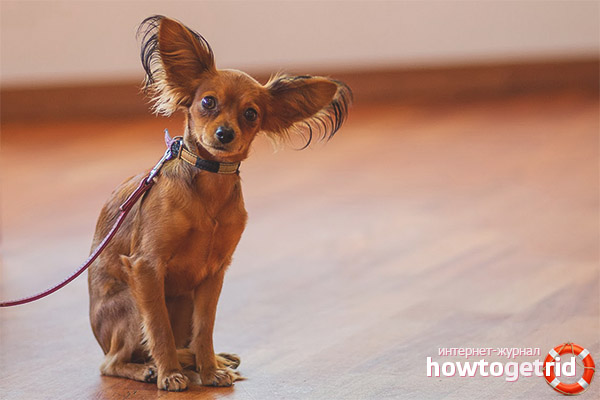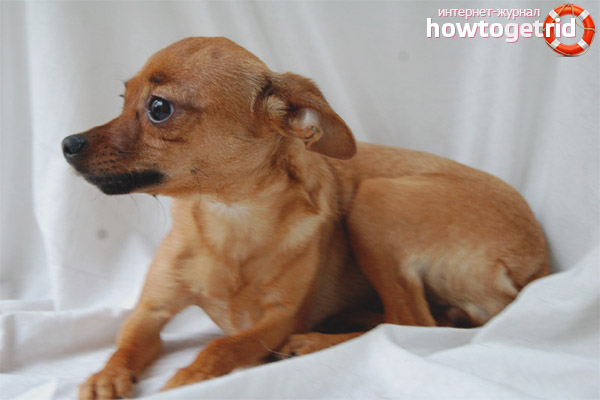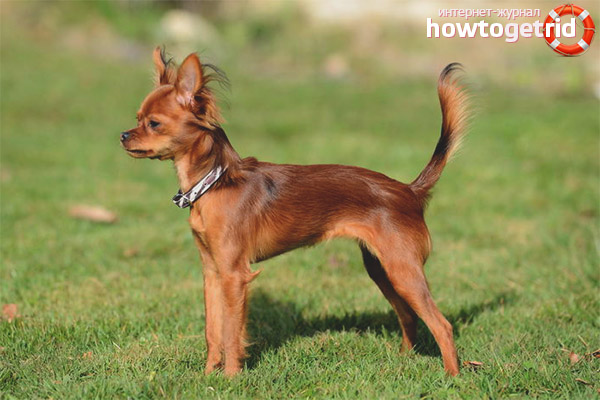The content of the article
- 1 Dog Breed History
- 2 Appearance of the Russian toy terrier
- 3 Character of Russian toy terriers
- 4 Health of Russian toy terriers
- 5 Care Features
- 6 Training and education of the Russian toy terrier
- 7 Interesting facts about the breed of Russian toy terriers
- 8 The cost of puppies of Russian toy terrier
- 9 Video: dog breed Russian toy terrier
These are tiny tiny animals bred on the territory of Russia, and are true metropolitan inhabitants. But this is not at all the pet who likes to sit on a pillow embroidered with velvet patterns somewhere in the apartment and be content with it. On the contrary, they want to constantly be active, move, and intolerant of boring pastime. Moreover, in comparison with large dogs, the toy terrier does not need to overcome several kilometers; it will be enough for them to regularly play in the apartment or on the street. These dogs can easily be taught various dances with the owner, circus acts and agility.
Dog Breed History
Previously, Moscow had a wide variety of names: from the third Rome and the golden-headed capital to the white-stone one. The city grew out of a number of small settlements that were located on the banks of the Moskva River, managed to gain a leading position among many other settlements that waged war among themselves. This city has become a home for many creative people, commanders or noble people. Of course, this information is known to us from historical textbooks, but it does not indicate that there was a breed of dog that was directly related to the capital. It was on the territory of Moscow that the Russian toy terrier was bred.
This breed of decorative animals was not formed as a result of a wonderful life. On the contrary, during the Soviet period, such dogs were not particularly respected, and by the middle of the last century they had practically disappeared from the face of the earth. But only thanks to a competent approach to selection, Moscow breeders were able to get a radically new variety. Muscovites have always loved dogs, and after the birth of Russian toy terriers, the dogs managed to get the love of many ordinary citizens.
The direct relatives of the dogs are the Prague rat rat, as well as the British toy terrier. These are the breeds that have been used since ancient times for rodent hunting. Russian toy from them got an energetic character, a love of activity and incredible agility. Initially, their hair was only smooth, but over time the dogs formed pleasant, externally and long tows, mainly on the tail and ears.
In the second half of the 19th century, Moscow hosted the participants of the first domestic exhibition of animals - dogs and horses. But, in addition to the pointing dogs and greyhound hunting dogs, business dogs were presented to the eyes of people there, in other words, decorative animals. At that time, it was dogs for aristocratic ladies that enjoyed the maximum demand from Muscovites. These dogs were called darlings. And, of course, they are very emotional. In addition, the translation of the word "toy" means a toy or some fun. Owners of toy terriers experience boundless love and tenderness for their pets. Of course, the shepherd can also be called with a special affection, but it is the Russian one who deserves the most diminutive treatment.
As it was customary to say at that time, the first Russian exhibition was held in accordance with English samples. There was no tribal goal before the exhibition, then only places of honor, cups and medals for animals were distributed.
Appearance of the Russian toy terrier
The standard includes dogs weighing up to 3 kg - this is a truly “airy” weightless doggie. Their height usually does not exceed 26 cm.
- The dog’s head is small, the forehead is elongated, when viewed from the side, it is slightly rounded. The cheekbones are smoothed, flattened.
- The muzzle of the island is of medium size. The lips are pigmented dark, the teeth are sharp, not too short. Scissor bite.
- The nose looks harmonious on the face, the lobe is pigmented according to the color or black.
- The eyes are set wide, straight. Partially convex, large and rounded.
- Ears are erect, very large and high.
- The neck is graceful, the muscles are dry. The neck bends smoothly, the withers are even.
- The body is square. The muscles are strong. Croup is located under the bevel. Tight belly.
- If the tail does not stop, it has a sickle shape, located below the vertebral line.
- The paws have fingers pointing forward, which are pressed tightly against one another. Claws of dark color, forelegs slightly larger than hind limbs.
- Color can be of different colors, sometimes colors are combined. It can be tan with brown or black, redhead combined with brown or purple.
- The coat can be short or long. In the second embodiment, the coat can reach 5 cm. The short-haired toy terrier has hair that is firmly attached to the body.
Character of Russian toy terriers
Decorative dogs can have a diverse mentality: both restless and fussy, so calm and quiet. But what they all can’t take away is courage and briskness. They are very groovy and playful. They love when the last word is theirs. Usually they voice if they meet someone at the doorstep of the house. It is there that they demonstrate sincere joy, but again, it will depend only on how the pet was raised.
Many toy terriers love to sit at the TV and watch it. They really sit staring at the screen, and look as if they understand what is at stake. If they happen to see any animal on the screen, the pets try to attract his attention and talk to him. If there is no need to protect someone, the dogs are friendly to other people and animals.
All the curiosity and interest of such an excellent companion is always intended for people, and in the process of walking the toy terrier does not have a special interest in relatives and animals of other breeds. As an ancestor of this dog, an English toychik caught small rodents in the UK. Consequently, the Russian toy terrier is also capable of not only catching a rat, but also an animal slightly larger, for example, of moles.
This is an extremely unusual and sincere creation. Most likely, their owners are exactly the same people, since dogs reflect in themselves their owner, all its advantages and negative sides, actions and disposition.
Health of Russian toy terriers
The life span of miniature dogs is usually longer than that of large representatives of canine breeds. Many toy terriers can live up to 16-18 years. But this will require constant attention to his health from the owner, and it is important to know not only the features of this breed, but also to carefully care for the doggie. The toy terrier has a rather fragile skeleton, and, accordingly, injuries in animals of this breed are at a fairly high level, especially at a young age.
For the full development of the body, including the musculoskeletal system, the pet must receive a full and balanced feed, receive timely and fully the amount of minerals and vitamins. Any active actions and physical exertion are required to expose the doggie gradually, slowly. In addition, it is important to keep puppies in check so that they cannot fall from high beds, tables and ottomans. The easiest way to remove tall objects from the room where the dog lives.
In Russian toy terriers, the first cervical vertebra is displaced (the so-called Atlanto-axial instability) - this leads to severe pain syndrome, and the animal has difficulty with the movement of the limbs. To restore the dog's ability to walk, surgery will be required. At the same time, miniature breeds often encounter hydrocephalus, which can also be managed with surgery.
Care Features
To take care of the dog in ordinary conditions is quite simple. They perfectly respond to any actions that are performed with him. But the dog should get used to this from childhood.
- It is necessary to expose pets to water procedures based on how often they take walks. If the owner does not want a stained dog to settle in a berth, he will need to be washed in a timely manner.
- Shedding overtakes the toy terrier once a year, very moderately. For combing, you will need to use a comb specifically designed for this. It should be of high quality, the teeth are blunt to avoid injuries of the skin.
- Ears should be washed more often to those dogs that have long hair. A tar effect for washing the ears shows a great effect, then conditioner is used to rinse.
- Russian toy terrier rarely encounters eye diseases. They almost do not flow, and if this happened, then this means the influence of an allergy factor on them. The situation requires contacting a veterinarian.
- The teeth of this decorative dog require special care. Initially, you need to pay attention to the lost milk teeth. A number of individuals may experience problems when the molars begin to grow, and at the same time, milk teeth remain. If you do not eliminate them in a timely manner, an incorrect formation of a number of teeth will occur, and this can result in periodontal disease.
- Claws need to be cut twice a month. The toy terrier has firm claws, it is difficult to grind them. If this manipulation is not performed, the dog will have difficulty walking.
- It is necessary to especially control the feeding of the pet. They love to bite, so you need to immediately raise a pet so that he does not look into the mouth of his owner. They are allowed to eat fatty foods. It is most convenient, at the same time, to offer them dry food. If you use a mixed type of food, you can not overfill it with fruits and vegetables, since allergens are found among them. If you have a long journey, the toychik will practically not drink, so you can use wet food.
- Pets are great for walking. Of course, they do not differ in particular whimsicality, and perfectly do without a walk. But, if at least a couple of times the dog visited outside her apartment, then she will often have a desire to walk outside again. A toy terrier is a companion dog, and she will be happy to take the idea of taking a walk even in the rain. While at home, the toy terrier uses an ordinary diaper as a toilet. By the way, many today use reusable diapers that can be washed.
Training and education of the Russian toy terrier
These pets spend a long time communicating with their beloved master. They love to sleep together, go shopping, sit on pens, but do not be mistaken, believing that they do not need to be brought up from childhood. Along with other dogs, toy terriers need training.
If a pet was brought up for the sake of showing at exhibitions, then it will be necessary to educate it from birth. They need not to be afraid of any touches, even from outsiders, as expert representatives will always need to touch the dog, feel it, look into its mouth to look at its teeth. And the toy terrier is forbidden to demonstrate anger and aggression in this situation.
Initially, such dogs pay attention to people, and they simply adore accompanying their owner everywhere. Of course, dogs are unlikely to experience great joy from competitions and contests, as these are very noisy events, there are a huge number of foreign dogs and unfamiliar faces. This constantly turns into stress, but if the owner is nearby with his support, then the pet will certainly experience sincere positive emotions.
The dog and the owner, demonstrating it at the exhibition, represent a common team. Therefore, it is important for the owner to have knowledge about veterinary features, to know the rules of training and the basics of physiology, to understand how different breeds of dogs are raised.
In order for the show process to be truly correct and look impressive, and the dog to be appreciated, the toy terrier should not only look great, but also demonstrate its best qualities. You can either turn to the masters of training for help, or independently master all the necessary disciplines.
There is a certain profession called “handler”. Such a person is training a dog so that she can get first places in beauty contests for dogs. His competence is training the dog in the rules of the show. He needs to help the animal show all its advantages and hide the negative sides. There are various organizations providing services. According to the German system, two people are engaged in raising a dog at once, one of which is engaged in raising a dog in the ring, and the second is located outside it and is trying to attract the dog's eye with a variety of tasty things, toys and other things. When one of the people shows something worthy of attention, the dog begins to stretch a string to look at it. And then the other person has the opportunity to evaluate the static and beauty of the dog.
Interesting facts about the breed of Russian toy terriers
It is hardly possible to find something that will be nicer than a puppy of a tiny toy terrier. You can always watch how these creatures are clumsy and awkward. It may seem that any item can be used by them in the gameplay. These are real fussy hooligans with a beautiful, friendly and sweet character. An adult has an idea when frisky play is justified and timely, and when you need to behave decently.
The cost of puppies of Russian toy terrier
A puppy can be purchased for about $ 150.
Video: dog breed Russian toy terrier












Submit